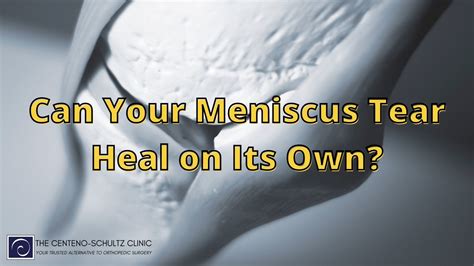Intro
Heal meniscus tear naturally with 5 effective ways, including physical therapy, knee braces, and pain management, to alleviate symptoms and promote recovery from meniscal injuries and tears.
The meniscus is a crucial component of the knee joint, providing cushioning and support to the bones and facilitating smooth movement. However, meniscus tears are a common injury that can cause significant pain and discomfort. If you're suffering from a meniscus tear, it's essential to understand the various treatment options available to promote healing and prevent further damage. In this article, we'll explore five ways to heal a meniscus tear, helping you get back on your feet and regain your active lifestyle.
A meniscus tear can occur due to sudden trauma, repetitive stress, or wear and tear over time. The injury can be debilitating, making everyday activities like walking, running, or climbing stairs a challenge. While surgery is sometimes necessary, many cases of meniscus tears can be treated with conservative methods. By understanding the causes, symptoms, and treatment options, you can take the first step towards healing and recovery.
The importance of seeking medical attention for a meniscus tear cannot be overstated. A proper diagnosis is crucial in determining the best course of treatment. Your doctor will likely perform a physical examination, review your medical history, and order imaging tests like an MRI or X-ray to confirm the diagnosis. Once you've received a diagnosis, you can begin exploring the various treatment options available. From conservative methods to surgical interventions, there are several ways to heal a meniscus tear and alleviate symptoms.
Understanding Meniscus Tears

Types of Meniscus Tears
The location and severity of the tear will play a significant role in determining the treatment plan. For example, tears in the outer third of the meniscus have a higher likelihood of healing due to increased blood flow. In contrast, tears in the inner two-thirds of the meniscus may require more aggressive treatment due to limited blood supply.Treatment Options for Meniscus Tears

Conservative Treatment Methods
Conservative treatment methods are often the first line of defense against meniscus tears. These methods can help reduce pain and inflammation, promote healing, and improve knee function. Some common conservative treatment methods include: * Physical therapy: A physical therapist can help you develop a customized exercise program to strengthen the surrounding muscles and improve knee mobility. * Bracing: A knee brace can provide support and stability to the knee joint, reducing stress on the meniscus. * Pain management: Over-the-counter pain medications, such as ibuprofen or acetaminophen, can help manage pain and inflammation.Surgical Treatment Options

Recovery and Rehabilitation
After surgery, it's essential to follow a comprehensive rehabilitation program to promote healing and restore function to the knee joint. This may include: * Physical therapy: A physical therapist can help you develop a customized exercise program to strengthen the surrounding muscles and improve knee mobility. * Bracing: A knee brace can provide support and stability to the knee joint, reducing stress on the meniscus. * Pain management: Over-the-counter pain medications, such as ibuprofen or acetaminophen, can help manage pain and inflammation.5 Ways to Heal a Meniscus Tear

Practical Tips for Healing a Meniscus Tear
In addition to these treatment options, there are several practical tips you can follow to promote healing and reduce the risk of further injury: * Avoid activities that aggravate the condition, such as jumping or twisting. * Wear proper footwear and use orthotics or shoe inserts to reduce stress on the knee joint. * Maintain a healthy weight to reduce stress on the knee joint. * Stay hydrated and fuel your body with a balanced diet rich in nutrients and antioxidants.Conclusion and Next Steps

If you have any questions or concerns about meniscus tears or would like to share your experiences, please don't hesitate to comment below. We'd love to hear from you and provide any additional guidance or support you may need.
What are the symptoms of a meniscus tear?
+The symptoms of a meniscus tear may include pain, swelling, stiffness, and limited mobility in the affected knee. You may also experience a sensation of the knee giving way or feeling unstable.
How long does it take to recover from a meniscus tear?
+The recovery time for a meniscus tear can vary depending on the severity of the injury and the treatment plan. With conservative treatment, recovery can take several weeks to several months. With surgical intervention, recovery can take several months to a year or more.
Can I prevent meniscus tears?
+While it's not possible to completely prevent meniscus tears, you can reduce your risk by maintaining a healthy weight, staying active, and avoiding activities that put excessive stress on the knee joint. Wearing proper footwear and using orthotics or shoe inserts can also help reduce the risk of meniscus tears.
